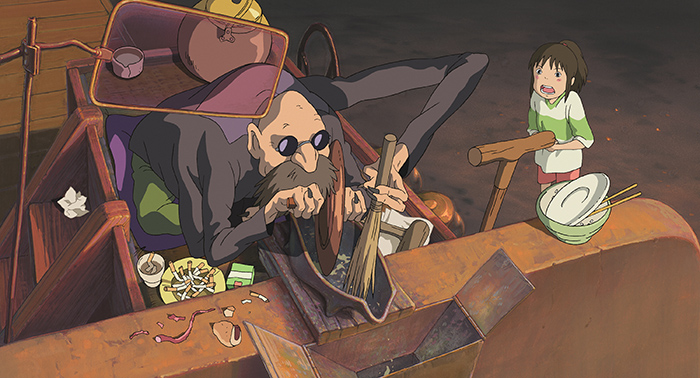Compared to most other countries, Japanese culture is constantly added to with each generation. That’s not to say that nations like the USA and the UK don’t have a culture – it’s that the ingenious way that Japanese artistic heritage from the Middle Ages and before has been adapted to become iconic applications such as the modern manga and anime we know today.
Most other countries can’t claim that their cultural offerings are grounded in as much history and tradition. As such, we can begin to see that anime – and its very specific style – is proliferating into western culture. Just how much does Japanese sci-fi and anime culture influence western TV and movies?
Humble Beginnings: How Did Anime Begin?
Sources aren’t set on when anime was developed. Some suggest the first anime was drawn around 1916-1917 by Shimokawa Oten, but as many records and the reels were destroyed, most suggest that a 1917 release containing 20 short anime films was its inception.
© Toei Co., Ltd.
Kenzo Masaoka released the first anime film with sound in 1933, while 1958 saw the release of the first anime feature, Hakujaden. Three years later, it premiered in America – and the west’s obsession with Japanese sci-fi culture began.
Japanese Sci-Fi Scooped Up by the West
One of the most prevalent aspects of Japanese culture that can be seen in western film and TV is the monster trope known as kaiju. Early sci-fi was filled with creatures that appeared from nowhere to wreak havoc (usually on Tokyo).
1954’s Godzilla paved the way for the films, which have changed shape throughout the years but are still popular today. Indeed, there is even an entire range of study just on the influence of Godzilla and kaiju. Other examples of kaiju films include the 31 sequels in the Japanese Godzilla series, Pacific Rim (2013), Dwayne Johnson’s 2018 film Rampage, and the Cloververse series of films – including the cinematic shocker of a series opener Cloverfield (2008), 10 Cloverfield Lane (2016) and The Cloverfield Paradox (2018).
TM & © TOHO CO., LTD.
The Pervading Influence of Japanese Culture
Japanese culture doesn’t just influence film and TV. Elsewhere in entertainment, anime is used as an inspiration. The Devil May Cry video game series was heavily inspired by anime – from the design of its characters to the progression of its story. Moreover, popular on Netflix, cartoon series Avatar: The Last Airbender was so influenced by anime that many are surprised to find that it was created in America.
This has even led to some calls to create a new category of anime produced outside of Japan. Elsewhere in entertainment, the sci-fi and anime themes doesn’t just influence TV and films but a wide range of products, as the Fortune Girl slot on some casino sites, by way of example. This online slot that pays tribute to the anime aesthetic, appealing to potential players by using designs and iconography of classic anime and Japanese sci-fi storytelling to deliver its gameplay.
How Does Anime Influence Western Storytelling?
Storytelling has also taken inspiration from anime and traditional Japanese tales. Anime – including long-running series such as Naruto, Pokémon, and Dragon Ball Z – has a distinct way of telling stories. The arcs are usually dominated by the ‘big bad’ or the villain of the day, while the heroes have a distinct journey to make. But as many beleaguered anime fans will attest to, there are also many filler episodes. These episodes help delay huge storylines and allow the anime to catch up with the original source material (often manga comic books).
One of the prime examples of this in the west is how the reception of The Walking Dead from AMC fluctuates to match whether it is reflecting the comic books or not. Traditional TV’s Sweeps Week meant that many drama shows delayed big events with unnecessary side stories in order to air their big set pieces or dramatic denouements when more people would watch. Netflix – and the shorter order of episodes it proliferates – counteracts this and removes the need for filler episodes.
The 1988 Japanese animated sci-fi film Akira is often lauded as one of Japan’s best cinematic exports, alongside Studio Ghibli’s 2001 film Spirited Away. Famously, George Lucas turned down an offer to show the former film to western audiences in 1987 because he felt they wouldn’t be interested. The film, when it eventually found its audience, turned many towards Japanese sci-fi and anime programming, and became a benchmark for which other media wanting to reflect the vibe would use. Indeed, Kanye West’s music video for Stronger is heavily based on Akira – according to its director.
Japanese storytelling is reflective of the culture and the traditions passed down, which have been remodeled into one of the most instantly recognizable media tropes globally. The themes behind Japanese sci-fi and anime are universal and can be applied to film, TV, gaming and entertainment in general in the west. As culture begins to transcend country boundaries, we should expect to see more anime influences throughout western media.


